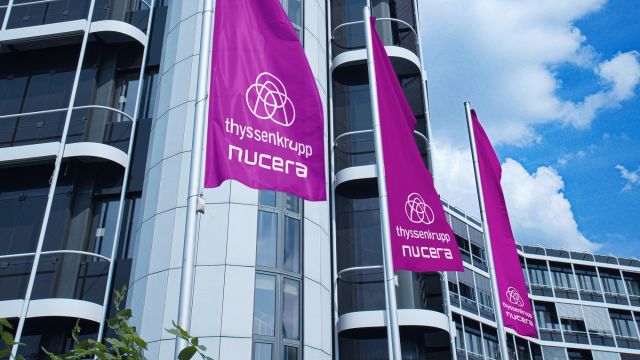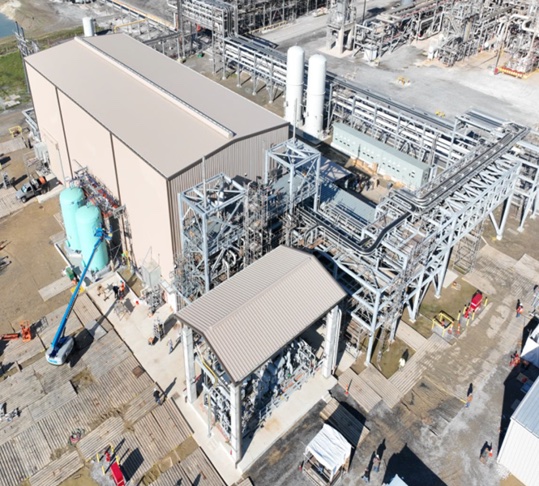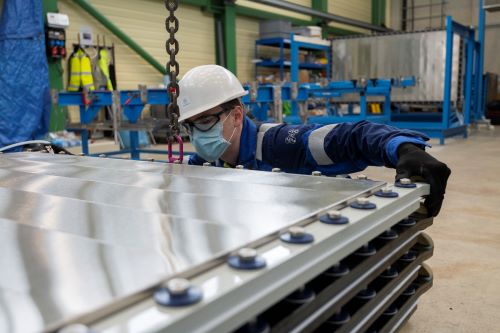
Thyssenkrupp Nucera headquarters. (Source: Thyssenkrupp Nucera)
As U.S. hydrogen players await final guidance on federal tax incentives, Germany-based electrolyzer specialist Thyssenkrupp Nucera has its sights set on the potential growth ahead.
The company has more than five decades of experience in electrolyzers, which use electricity to split water molecules into hydrogen and oxygen. The global technology provider has installed more than 600 projects with a total capacity of more than 10 gigawatts (GW).
The company was chosen to install an electrolysis plant with a capacity of more than 2-GW for Air Products’ $8.4 billion NEOM hydrogen project in Saudi Arabia. The company also is supplying its standardized 20-megawatt (MW) electrolysis modules—called scalum—for the H2 Green Steel project in Sweden.

Thyssenkrupp Nucera is now advancing projects in one of its core growth markets: North America.
The U.S. Department of Energy awarded Nucera a $50 million grant earlier this year to further develop production of its gigawatt-scale electrolyzers. The company is also awaiting the startup of fertilizer manufacturer CF Industries’ green ammonia project in Donaldsonville, Louisiana. Here, Nucera’s high-performance 20-MW electrolyzers will produce hydrogen on an industrial-scale.
Hydrogen is seen as a promising way to decarbonize hard-to-abate sectors such as steel and cement, while serving as a low-emissions alternative in areas such as transportation and energy storage. However, some hydrogen projects are challenged today by economics as developers wade market conditions, try to secure funding and watch for clarity on incentives.
Thyssenkrupp Nucera CEO Werner Ponikwar recently shared insight on the electrolytic hydrogen sector and the company’s plans in the U.S. during an exclusive interview with Hart Energy.
(Editor’s note: This interview was edited for clarity and style.)
Velda Addison (VA): How would you describe the electrolytic hydrogen sector today in the United States?
Werner Ponikwar (WP): In the United States, I believe this is really now an inflection point. What we certainly need here in the U.S. is predictability around regulations. And certainly, if you want fit-for-purpose funding rules—which are in the making—but they need to be stabilized now and finalized. Once that happens—fingers crossed that it’s going to happen very soon—then I see this really taking off quickly.
VA: Clarity on the hydrogen production tax credit could come before the election or after the election. Is there anything that you’re hoping to see or change in that tax credit policy?
WP: As a technology provider, I believe our roots are strong, enabling us to address all previously discussed technology aspects. However, greater operational flexibility would allow us to increase the operating hours of electrolyzers, significantly reducing the cost of hydrogen production. More relaxed rules would enable us to optimize our technology and infrastructure, ensuring we can deliver hydrogen more efficiently and cost-effectively. This would not only drive down costs but also accelerate the adoption of clean hydrogen solutions. Extending the eligibility period beyond Jan. 1, 2033, to ensure long-term investment stability and continuous growth in the clean hydrogen sector is another factor that would be favorable.

VA: Hydrogen is still considered expensive compared to other forms of energy. What can be done or what is your company doing to help bring down the cost of electrolyzers, which is a big component of that?
WP: Well, actually, it’s not such a big component. The majority of the cost comes from electricity: roughly 60%. Electricity costs can be up to 70%, of the cost of a kilogram of hydrogen, making it the biggest lever. However, the cost of electrolyzers also plays a part, and we are well aware of that. We believe that in the 50-plus-year history of the company developing electrolyzers, we have come a long way in reducing the costs already. Still, we see further potential for cost reduction, and that’s what we’re actively working on our systems. By fully standardizing the system, we can move into serial manufacturing, which requires volume and market demand.
But of course, you can benefit from higher procurement volumes of your parts and materials. Additionally, repeating the same engineering process can minimize requirements. And certainly, there’s also technological improvements that we’re currently driving that will further bring down the cost of the electrolysis system. So, we believe that over the next years, we will see the cost of the system further come down, and that will certainly support the development of the green hydrogen industry.
VA: A lot of projects have been announced and there’s a ton of uncertainty about whether most of those projects will actually happen. How do you plan for future demand?
WP: The projects which you see out there are different. Some are driven by proven project developers who struggle because they need certainty in funding, regulation and risk minimization. They also need to make sure that offtake agreements are in place to achieve a bankable project. And, that seems to be more difficult than most of the project developers would have expected.
On the other side, we see projects that are more driven by strategic investors, like the industrial gas companies, which typically have access to renewable power already. These investors often partner with companies developing renewable energy, operate the systems themselves, and create their own offtake. By establishing their own ecosystem, they can move quicker ahead simply because they’re not so much depending on so many external factors.
VA: How do you see the market evolving over the next 10 years and what is your company’s role in that?
WP: I think the market will develop almost exponentially. We are now really at a trigger point. Once the regulations and the rulings, in particular here in the U.S., are firm, then I see a lot of projects would move ahead based on the very attractive conditions that they can leverage for the projects. And of course, you see that also the demand is now starting to increase in the market not only here in the U.S. but also in Europe quite significantly. There will be also lots of opportunity to export from the U.S. into the European Union, because it is clear they will not be able to get self-sufficient in terms of generating hydrogen. So, they will be dependent on imports. The objective conditions in the U.S. will facilitate this transition.
VA: Speaking on projects, can you provide an update on the project you are working on with CF Industries in Louisiana?
WP: At CF Industries, we are looking forward to flipping the switch soon. Commissioning activities are nearing completion. We are finalizing completion and our system is ready to go. We are all very excited about that project coming online here in the U.S. This will be a first of its kind for thyssenkrupp nucera and one of the world’s largest alkaline water electrolyzers.
VA: The company also recently received a grant from the Department of Energy. What are your plans for those funds?
WP: That’s correct. We have been selected for $50 million in funding to build a manufacturing site here to accelerate the automation and the mass manufacturing of our electrolysis cells here in the U.S. That certainly will also help us to build up our capacities. We believe there’s significant potential, and over the next few years, we’re going to build up and improve the manufacturing process. We are very excited about the opportunity to receive funding from the DOE.
VA: Can you tell me more about the greatest market opportunity for electrolyzers? Who are your customers today, and how do you see that evolving in the future?
WP: Today, we see in particular the chemical industry here, predominantly ammonia and fertilizers, but also methanol, playing a role already. We see this particularly in Europe because there are also some regulations around the refinery industry, which is already consuming a lot of hydrogen and switching over to green hydrogen now. We see steel production, particularily in Europe but also now coming into the U.S., converting existing steelworks from using coal for blast furnaces to the so-called direct reduction of iron ore, where hydrogen is used to reduce the iron ore. This way, you’re not polluting the atmosphere with any CO2 anymore. This is currently a very arbon intensive process. That’s a very concrete application where we see a lot of movement.

VA: The electrolyzer sector is also seeing smaller companies, startups, enter. What sets your company apart from others?
WP: We bring extensive experience not only in manufacturing but also in erecting and building up industrial-scale electrolyzers, and that really sets us apart. We’ve been doing that for more than 50 years in the industry. We know what is required to do that at a large scale as well. This is a lot about the reliability of systems. It's crucial to avoid any disruptions within a multi-hundred megawatt or even gigawatt system, as they can be extremely costly. Then, of course, we know how to scale up those systems. We are also very experienced in building projects like that.
Apart from that, being a very mature company as well, we are running on a very strong balance sheet, which is also important because customers want to make sure that you are around and supporting them over the next decades ideally. And of course, with those smaller early developing startups, they have difficulties with that. Also, not to forget, we have been running our chlor-alkali electrolyzer business for many decades, which gives us a lot of stability. We have a very stable cash flow with that. That is certainly also helping us to invest in building up new capacities for the green hydrogen market, and that is something that is differentiating us in the market.
Recommended Reading
Halliburton, Coterra Launch Fully Automated Hydraulic Fracturing Tech
2025-01-06 - Halliburton Energy Services and Coterra Energy’s initial rollout of their autonomous hydraulic fracturing technology led to a 17% increase in stage efficiency.
Shale Outlook: E&Ps Making More U-Turn Laterals, Problem-Free
2025-01-09 - Of the more than 70 horseshoe wells drilled to date, half came in the first nine months of 2024 as operators found 2-mile, single-section laterals more economic than a pair of 1-mile straight holes.
Tracking Frac Equipment Conditions to Prevent Failures
2024-12-23 - A novel direct drive system and remote pump monitoring capability boosts efficiencies from inside and out.
E&P Highlights: Feb. 10, 2025
2025-02-10 - Here’s a roundup of the latest E&P headlines, from a Beetaloo well stimulated in Australia to new oil production in China.
E&P Highlights: Feb. 3, 2025
2025-02-03 - Here’s a roundup of the latest E&P headlines, from a forecast of rising global land rig activity to new contracts.
Comments
Add new comment
This conversation is moderated according to Hart Energy community rules. Please read the rules before joining the discussion. If you’re experiencing any technical problems, please contact our customer care team.






